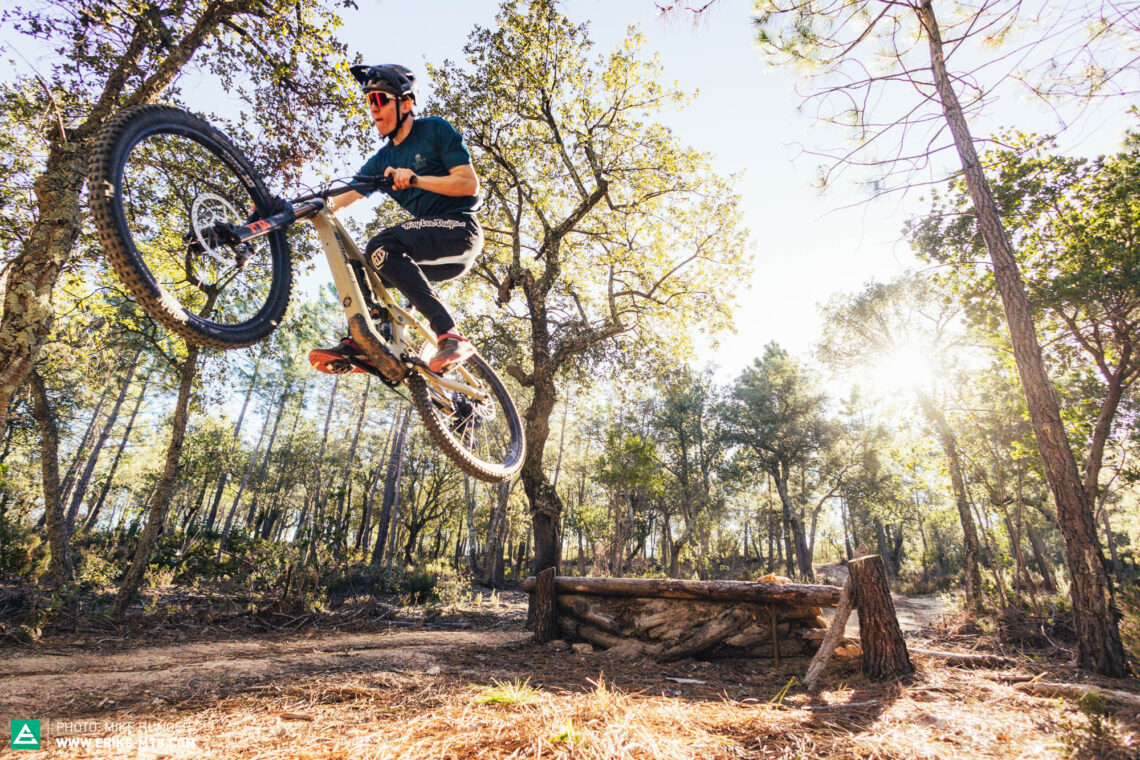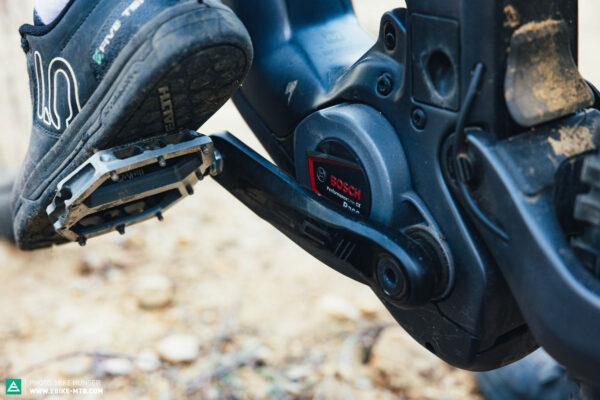An incomparable comparison: what influence does the drive unit have and how does it change the handling of an eMTB, all else being equal? We tested four near identical SIMPLON Rapcon models in a direct comparison – one each with a Bosch CX, Pinion MGU, TQ-HPR50 motor, as well as the analogue version.



Ceteris paribus – most of us will have encountered this Latin phrase in maths or physics class, though you might not remember it. It means “all else being equal”. What happens in a complex system when all conditions are fixed and you change just a single variable? Ceteris paribus is crucial for scientific experiments, in order to determine the isolated effect of one variable.
The ceteris paribus assumption doesn’t exist in the ebike industry, or rather: not yet. As eMTB editors, it is our job to fully understand and evaluate ebikes as complex systems, and to convey their unique characters to our readers. A direct comparison of individual parameters, like the motor, is neither possible nor is it necessarily expedient. Our eMTB and motor group tests regularly emphasise that a motor is only as good as the bike it’s in. But now SIMPLON have stepped onto the scene with the Rapcon and a broad choice of motors to choose.

Three motors, four bikes, one recipe for success – The SIMPLON Rapcon
The premium Austrian bike brand is a permanent fixture in our group tests and the group tests of our sister magazines. The SIMPLON portfolio includes a wide range of analogue and electric mountain bikes. The bikes can be built to your liking using the in-house configurator, so almost no SIMPLON is the same.
But you can also use the configurator to build four almost identical SIMPLON mountain bikes, with the only difference being the motor and its corresponding hardware.
The gravity-focused SIMPLON Rapcon is available both as an analogue mountain bike and as an eMTB with a TQ-HPR50, Bosch Performance Line CX, or most recently, Pinion MGU E1.12 motor. We’ve pitted it against the best MTBs and eMTBs in a variety of configurations and numerous tests, but never against itself. How does the bike and its handling differ if you only change the motor system, and are there other unexpected differences?



What is the difference between the Rapcon, Rapcon and Rapcon, and which is the best Rapcon?
Before getting to the practical part of our ceteris paribus experiment, we must define the variables. That means laying the hard facts of the four Rapcons and their different motor systems on the table. Starting with the prices, the analogue SIMPLON Rapcon is available from € 5,599. The SIMPLON Rapcon Pmax TQ with the TQ-HPR 50 motor starts at € 8,699. You’ll have to fork out at least € 8,999 for the Rapcon Pmax CX with a Bosch motor. And the Rapcon Pmax Pinion has the highest barrier to entry, with prices starting at € 9,999.
The large price differences were reduced slightly once we pimped the test bikes according to our preferences. After upgrading to FOX FACTORY air suspension with a burly FOX 38 fork and FLOAT X2 shock, the first three SIMPLON Rapcons were specced with wireless SRAM GX Eagle Transmission drivetrains. The SIMPLON Rapcon Pmax Pinion doesn’t offer any drivetrain options in the configurator because there’s an integrated gearbox in the motor. Further upgrades like powerful brakes, outrageously expensive wheels, and long-travel dropper posts rounded our test fleet off perfectly.
As tested, with all bikes being specced almost identically, the analogue Rapcon underwent the steepest price increase, ringing in at € 8,614. The TQ variant had the smallest price increase, coming to € 10,365. The Rapcon Pinion dropped down the list, becoming the second most expensive bike at € 11,934. Taking the lead is the Bosch-equipped Rapcon with the limited-edition Bosch Performance Line CX-Race motor, which can be yours for a whopping € 11,984.


The first differences between the individual motor systems already show up in the configurator. The TQ system offers the least room for configuration. A 160 Wh range extender for € 620 is the only motor system upgrade available. Regarding the main battery, remote, and display, the TQ system is about as indulgent as Henry Ford when it came to the colour of the Ford Model T: “You can have it in any colour, as long as it’s black.” The permanently integrated 360 Wh main battery, HPR Display V01, and remote are mandatory. There are no other options besides this.
With the SIMPLON Rapcon Pmax CX, on the other hand, the Bosch parts catalogue opens up a wide range of remotes, displays and batteries to choose from. The Rapcon CX is available with either a 500 or 750 Wh battery. We opted for the larger model for an extra € 330. Therefore, we didn’t go for the 250 Wh range extender, which would have cost us € 475 extra. The stand out feature of the Rapcon CX is that you can choose between the Performance Line CX motor and the CX Race variant for an additional € 550. We get weak at the sight of the grey housing and red accents, compelled to choose the race-proven model.
The Rapcon build with the Pinion MGU motor obviously has no drivetrain options in the configurator, though you’ve got a choice of three display and remote combos. One of the most noteworthy features of the motor system, which was created in cooperation with FIT, is the choice of battery sizes. The smallest main battery starts at a considerable 720 Wh capacity. For € 200 more, you can get the bigger battery with an insane 960 Wh (only on sizes L and XL). You can top that up with another 470 Wh with the € 780 range extender, which attaches to the down tube. With a capacity totalling 1,430 Wh, you won’t have to worry about charging until the next summer solstice. We went for the more reasonable “small” 720 Wh option.

Handling and maintenance – How time-consuming and labour-intensive are the four SIMPLON brothers to maintain?
How do almost € 43,000 worth of test bikes weigh up on the scales? The analogue SIMPLON Rapcon can be picked up and weighed with one hand, coming in at 15.86 kg in size M (the same size as all the other models).
The almost identical-looking Rapcon Pmax TQ tips the scales at 19.98 kg. We had to use both hands for the 23.94 kg Rapcon Pmax CX, and the SIMPLON Rapcon Pmax Pinion pushed our 25 kg scale to the limit, weighing in at 25.02 kg.
If you encounter a hike-a-bike section on the trail, it’s relatively easy going with the TQ Rapcon, which can even be shouldered if the push-assist doesn’t help. Of course, the same applies to the analogue Rapcon.
But the weight differences are noticeable when loading and handling the bikes off the trail, too. You can still get the analogue Rapcon on the roof rack on your own. Handling the Rapcon TQ is just slightly heavier. That’s a good thing considering that the permanently integrated battery means you’ll have to carry the bike upstairs into your apartment for charging if you don’t have access to a power outlet downstairs.

The Bosch equipped Rapcon turns out to be a bit unwieldy. Unless you feel like struggling with the bike’s almost 24 kg heft, removing the battery is a somewhat fiddly affair, be it for charging or transporting the bike. The long Bosch battery can only be accessed via the bottom of the down tube. To remove it, you must first remove the skid plate, pull out a plug, push it aside, and then shake the very tight fitting battery out of the frame.
The Pinion Rapcon is even heavier, but at least it’s a bit more user-friendly when it comes to removing the battery. If you have the key at hand, a quick twist of the lock is all it takes to make the battery pop out of the frame. However, if you want to transport the bike with the battery removed, it will be left with a gaping hole in the down tube.
In return, the Pinion Rapcon is easy on the nerves of home-mechanics when it’s time for maintenance. It’s the only eMTB without a chain, rear derailleur, and cassette. All the gears are encapsulated with the motor. According to Pinion, the motor only needs an oil change every 10,000 km. There’s no need to lubricate the belt; it’s enough to spray it down with a hose to wash off the worst of the dirt. The three somewhat lighter, chain and derailleur equipped bikes, on the other hand, require regular cleaning and lubing.

It’s clear that despite their similarities, handling the four Rapcons can be a vastly different experience. But enough of the chit chat, it’s time to head out there and find out how the Rapcon siblings are received by you folks.
Street credibility – How are the different SIMPLON Rapcons received by the bike community?
If you approach a group of analogue riders with either the analogue Rapcon or the Rapcon Pmax TQ, you will be welcomed with open arms. SIMPLON have integrated the TQ-HPR50 system so seamlessly that it’s hard to distinguish from the analogue model.

The motor itself is whisper-quiet and offers such natural feeling support that you can cruise along with a group of analogue riders without getting noticed.
The Bosch powered Rapcon Pmax CX is much less discreet. Although SIMPLON have done a neat job of integrating the motor, the oversized tubes have eMTB written all over them. At the latest, the cat will be out of the bag once you leave the rest of the crew behind in a cloud of dust with just three pedal strokes.
It also makes it difficult to agree on a route to the trailhead. While analogue riders and the stealthy Rapcon Pmax TQ – which has infiltrated the group unnoticed – will prefer sparing their energy on the way to the trailhead by taking the service roads, the Bosch rider won’t want to pass up any climbing challenges along the way, constantly making small detours to find the most technical ascent.
Although the greyish and somewhat prominent CX-Race motor will draw appreciative glances amongst full-power eMTBers, it won’t help you make friends with analogue and light eMTB riders due to the considerable performance gap.


When the Rapcon Pmax Pinion rider joins the group, the first question they’ll hear is whether they’ve chosen the European route or will rather be crossing the Sahara as they circumnavigate the globe. Bikes with Pinion gearboxes and belt drives are very popular amongst long-distance riders, and that just makes this system really stand out from the crowd. Thanks to the massive battery, the capacity of which can almost be doubled in the configurator, the Pinion Rapcon further exudes slightly more expedition vibes than its sportier Rapcon siblings. The Rapcon Pinion is also more noticeable on the trails than the other eMTBs. Not because of a slapping chain, which it doesn’t have, but due to the slightly louder hum produced by the motor and the gearbox, especially in the lower gears.
SIMPLON did a great job of integrating the Pinion MGU E1.12 motor system, but as with almost all Pinion MGU bikes, the Rapcon Pinion has a beefy look. It’s the only ebike in the group with ventilation slots on the head tube, supplying the battery with a stream of fresh air even on the hottest rides through Death Valley.
But what do you care about the superficial differences and what others think? Ultimately, what really matters is that the eMTB appeals to you. With the Rapcon series, SIMPLON pursue a unique concept that must suit your riding style.

“Same-same, but different, but still same” – The subtle, hidden differences between the four Rapcons
SIMPLON would not be SIMPLON if the Austrian brand didn’t make slight adjustments to the frames in ways that go beyond the integration of the various motor systems. So, apart from the motors, the bikes aren’t quite the same, which you’ll see when looking at the geometry. Strictly speaking, this means that the ceteris paribus assumption doesn’t apply. However, they all follow the same concept.
The Rapcon recipe is all about finding the perfect balance of composure and agility, resulting in maximum downhill performance – across all frame sizes. Therefore, SIMPLON adapt the chainstay lengths and the progression, including the rear kinematics, to suit the various frame sizes.
The geometry figures of the four motor variants already hint at their gravity intentions. The analog Rapcon and the TQ Rapcon are virtually identical. The Bosch offshoot requires just small adjustments to the frame geometry details.
The Pinion variant, on the other hand, is a little more of an outlier. It has a minimally steeper head angle, a static chainstay length – the longest of all – and a longer wheelbase compared to the in-house competition. For those who love numbers, we’ve gathered the geometry figures of our four test bikes and put them into the following table. Enjoy:
| Size M | Rapcon | Rapcon Pmax TQ | Rapcon Pmax CX | Rapcon Pmax Pinion |
|---|---|---|---|---|
| Seat tube | 395 mm | 395 mm | 395 mm | 410 mm |
| Top tube | 590 mm | 589 mm | 588 mm | 584 mm |
| Head angle | 64.0° | 64.0° | 64.0° | 64.2° |
| Seat angle | 78.0° | 78.0° | 78.6° | 78.7° |
| Head tube | 104 mm | 104 mm | 112 mm | 108 mm |
| Chainstays | 438 mm | 438 mm | 441/439 mm | 447 mm |
| Wheelbase | 1,234 mm | 1,234 mm | 1,240 mm | 1,244 mm |
| BB Drop | 32 mm | 32 mm | 25 mm | 26 mm |
| Stack | 633 mm | 633 mm | 633 mm | 633 mm |
| Reach | 455 mm | 455 mm | 455 mm | 455 mm |
Due to the steeper seat tube and head tube angles, and the longer rear end, the Pinion Rapcon’s centre of gravity should theoretically be further forward than on the other SIMPLON Rapcon eMTBs. The weight of the rear derailleur and cassette is also eliminated, reducing the unsprung mass at the rear. These components are integrated into the Pinion MGU E1.12, further shifting the centre of gravity forward. According to SIMPLON, the proven Rapcon linkage performs even better on the Rapcon Pmax Pinion. We conducted our own tests, and encountered both subtle similarities and striking differences.

Eeny, meeny, miny, moe – Which system suits you?
For our ceteris paribus group test, we chose the incomparable trails and atmosphere of Girona in northeastern Spain. There, the analogue, Bosch, Pinion and TQ SIMPLONs already garnered a lot of street credibility on route to our test track.
The SIMPLON Rapcon Pmax Pinion leaves the biggest impression on the transfers. It has the plushest suspension of all Rapcon variants, offering the most long-distance comfort. Thanks to the powerful Pinion MGU E1.12 system, you can get shuttled through the countryside without breaking a sweat, and the semi-automatic shifting does the rest.
We compared the efficiency of the four “motors” on a not entirely representative test-loop of approximately 12 km, covering 550 vertical metres. To avoid wasting time, we only used the highest support modes. The three ebikes completed the loop hot on each others’ heels, and all of them were back at the start line after 50 minutes at the most – and let’s just say there’s little point including the analogue model at this point ;).

The fuel gauge on the Rapcon TQ dropped to about a quarter, using up 73% of the battery capacity on our test loop. For the sake of simplicity, we can therefore say the TQ motor consumed around 270 Wh, though the percentages don’t equal watt-hours one-to-one. In the aggressive Race mode of the Bosch Performance Line CX Race motor, the Bosch Rapcon drained a good 40% of the battery, with the display still showing 59% remaining capacity, using 300 Wh of the 750 Wh tank. The Pinion motor in the Rapcon Pmax Pinion proves to be particularly suitable for long distances, only treating itself to just under a quarter of the battery capacity, according to the display. It drops to 75%, which corresponds to a consumption of 180 Wh from the 720 Wh battery, assuming our simplistic 1:1 calculation. As always, battery consumption is heavily dependent on the riding style and the rider (weight), making it difficult to replicate. As with any US car advertisement, this all comes with the following disclaimer: “your mileage may vary”.

The analogue SIMPLON Rapcon completes our test loop only as fast as you’re able to pedal, of course. However, it should be noted that it climbs impressively for such a capable, gravity-focused bike. The rear suspension strikes a good balance between efficiency and sensitivity, pedalling without bobbing too much yet offering plenty of traction on steep, technical climbs. Other enduro bikes could learn a thing or two from the SIMPLON Rapcon.
Only the ground clearance is somewhat limited on the analogue Rapcon: it has a relatively low bottom bracket as is, and it’s the only bike on test with 170 mm cranks, which increases the risk of pedal strikes. The three ebikes don’t need the extra leverage to generate propulsion, relying on stubby 160 mm cranks.
The SIMPLON Rapcon Pmax TQ feels very similar to its analogue sibling going uphill. The very natural assistance and quiet operation of the TQ-HPR50 motor simply makes you feel like you’ve got super strong legs, rather than feeling like a motor is pushing you uphill. The respectable climbing qualities of the analogue Rapcon, coupled with the support from the motor, gives you the confidence to tackle even the most technical ascents. But it doesn’t get up the climbs as effortlessly as the Bosch Rapcon, for example. To extract the maximum power from the TQ-HPR50 motor, you must pedal at high cadence, which proves to be challenging on very rough terrain since the bottom bracket is as low as on the analogue Rapcon.

While the analogue Rapcon and the TQ Rapcon claw their way up the mountain like Alex Honnold, the SIMPLON Rapcon Pmax CX with the Bosch CX Race motor is the mountain goat in the quartet, conquering the summits in a gallop. The incredibly responsive and powerful motor catapults the CX Rapcon up every climb. The long sustained assistance lets you maintain your momentum while keeping the cranks horizontal. That way you’ve got more ground clearance and are able to conquer obstacles with ease. There’s no risk of the motor grinding to a halt on a long climb, even if your legs get tired. The smooth SRAM GX Transmission drivetrain on our test bike also provides a wide range and pleasant gearing increments for technical climbs. Furthermore, if you approach a climb in a gear that’s too high, it will reliably shift into an easier gear even under high loads, without feeling like you’re splitting the rear derailleur in two.
We were hoping for a little more from the SIMPLON Rapcon Pmax Pinion on the climbs. Although it’s just as powerful as the Bosch counterpart on paper, it can’t keep up with the CX Race motor in terms of actual power delivery and the sustained response. Even the ample traction generated by the rear end can’t help it keep up with the Bosch-powered Rapcon. The internal gearbox offers a wide gear range and lots of torque in the low gears. However, this is not as directly linked to the pedalling input as with the Rapcon CX. The shifting also takes some getting used to compared to the bikes with derailleurs. The Pinion gearbox times the shifts itself. When shifting gears, the cranks spin freely for about an eighth of a turn, which can throw you off balance and mess up your timing.

The excellent balance of all four Rapcon ensures intuitive and confidence-inspiring handling on the descents. Nevertheless, the analogue and TQ Rapcons outperform the two full-power eMTBs on the descents. Neither the CX- nor the Pinion-powered Rapcon can keep up with the agility and liveliness of the two lighter models. While the two “big” eMTBs can make you doubt whether you’ll clear certain gaps, their lightweight siblings almost let you hit any jump without first gauging the distance.
There are some differences between the Rapcon TQ and the analogue model, nonetheless. The analogue Rapcon sets the bar in terms of agility, whereas the TQ Rapcon is a bit more composed and slightly less flappable in the air – the additional weight does have some benefits.

If you plunge headlong down the trail on any Rapcon, all four (e)MTBs have enough reserves to forgive overshot landings or missed lines. Blasting over roots and ploughing through rock gardens, the Rapcon family offers loads of traction and stability, thus instilling you with high levels of confidence. Only the somewhat sluggish Pinion SIMPLON has a hard time keeping up. It has the softest suspension of all four models, and the rear wheel sticks to the ground. But the more front-heavy Pinion Rapcon tends to dive deeper into its travel when braking before the corners. In extreme situations, this can make the front wheel wash out, whereas the other three contenders can navigate the tightest corners.
Even if the four SIMPLON Rapcons seem like quadruplets at first glance – apart from the motors – the Pinion Rapcon didn’t inherit quite the same sporting genes as its three siblings. In return, you get high-capacity battery options, the plushest, most comfortable suspension, semi-automatic shifting, and a low-maintenance belt drive, making it the best option for touring.

So, which model, or which motor, suits you best? If you had to choose one common denominator to distinguish the handling of the four SIMPLONs as clearly as possible in order to find out which type of rider they would suit, it would be “sporty”. Admittedly, you could argue about whether a capable descender is more or less sporty than one that excels on technical climbs. Nevertheless, for the purposes of this comparison, we’ll say the analogue Rapcon is at the sportiest end of the spectrum, followed by the TQ Rapcon, then the CX Rapcon, and the least “sporty” option being the Pinion Rapcon. The analogue Rapcon is the most demanding, but it rewards active riders with the highest degree of agility. Lack of input doesn’t get punished as much on the full-size eMTBs, compensating for it with their powerful motors. But they also absorb more of your power when you’ve got an active riding style, resulting in a relatively passive handling.
The chicken and egg problem – Does the motor affect the bike or vice versa?
Thanks to four iterations of the supposedly same bike, SIMPLON manage to cover a relatively wide range of use cases. We don’t know if this was their intention.
Even if the basic elements of the Rapcon recipe have been retained, the handling of the four bikes differs significantly. It goes beyond the different motor parameters. The differences are strongly determined by the integration of the motor system, as well as by small adjustments made in order to harmonise the bike’s character with that of the motor. It’s not clear how much the versatile Rapcon platform influences, limits, or favours the performance of the different motors and, conversely, how much the different motors’ characteristics rub off on the bike’s inherent traits. We don’t think we’ll be able to conduct a more direct comparison of the different motors in the near future, either, yet our first attempt still leaves us with many unanswered questions.
If there’s one thing this experiment has shown us, it’s that our mantra can be reversed. Both are true: a motor is only as good as the eMTB in which it’s fitted, but an eMTB can also only be as well-suited for an intended use as the motor fits this purpose. A light-footed mountain bike will be severely limited by a 9 kg motor system, no matter how efficient the pedalling. It would be more likely to lead to an imbalanced feeling bike. And, conversely, no matter how efficient the suspension, a light eMTB won’t be able to compensate for the raw power of a full-size eMTB on technical climbs.


However, this realisation comes with certain caveats because it cannot be transferred directly to any other eMTB, and it could be proven wrong in the coming years. For more meaningful results from a direct motor comparison, we would have to repeat our ceteris paribus experiment with other identical platforms to determine how much the handling of an eMTB is influenced by the motor, and how much by the platform itself. Modern motors can already be tuned so much by the software alone that you could be fooled into thinking that they’re two completely different systems. The smaller, lighter, and more powerful these systems become, the more pronounced this effect will be. So things stay exciting, and the question of which system suits whom is still far from being answered.
You’re unlikely to get any closer to a direct motor comparison than with the four SIMPLON Rapcons. Although the motor has a big effect on the character of each Rapcon, it’s not the only determining factor. Instead of focusing on a motor when buying a bike, you should think more about how you intend to ride the eMTB. Doing so will expand your horizons, and you’ll be more likely to find your dream bike, with a motor and concept that suits your needs.
Visit simplon.com for more information about our test bikes.
Did you enjoy this article? If so, we would be stoked if you decide to support us with a monthly contribution. By becoming a supporter of E-MOUNTAINBIKE, you will help secure a sustainable future for high-quality cycling journalism. Click here to learn more.
Words: Rudolf Fischer Photos: Mike Hunger









